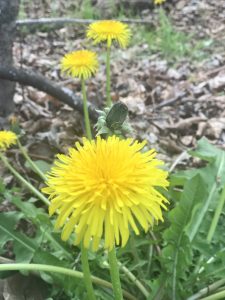 Spring. What better way to awaken then immersing myself in green: plants, flowers, trees, fungi. My friends Marty, Janie and I joined Karen Sherwood of Earthwalk Northwest for a Wild Food Foraging Spring Celebration. A day: in the weeds, the kitchen, the dining room. We met in the Earthwalk classroom where Karen introduced ethical principles and of wild food foraging guidelines. She explained how plants and medicine go hand in hand. Bringing wild foods onto our plates is a way to reconnect with the earth. Our food sources are becoming compromised and depleted. They lack the micronutrients we need to truly flourish. In Bread, Wine Chocolate, author Simran Sethi, describes the last century’s dramatic shifts we’ve experienced in food and agriculture. Foods are beginning to look and taste the same. Ninety-five presence of the world’s calories are now coming from only 30 species. Our foods are primarily made up of corn, wheat, rice, palm oil and soybeans. We are losing the delicious, diverse variety of food. Karen encouraged us to learn to incorporate wild foods in our diet every day. In learning about one new plant friend a week we develop a relationship with the life forms that sustain us.
Spring. What better way to awaken then immersing myself in green: plants, flowers, trees, fungi. My friends Marty, Janie and I joined Karen Sherwood of Earthwalk Northwest for a Wild Food Foraging Spring Celebration. A day: in the weeds, the kitchen, the dining room. We met in the Earthwalk classroom where Karen introduced ethical principles and of wild food foraging guidelines. She explained how plants and medicine go hand in hand. Bringing wild foods onto our plates is a way to reconnect with the earth. Our food sources are becoming compromised and depleted. They lack the micronutrients we need to truly flourish. In Bread, Wine Chocolate, author Simran Sethi, describes the last century’s dramatic shifts we’ve experienced in food and agriculture. Foods are beginning to look and taste the same. Ninety-five presence of the world’s calories are now coming from only 30 species. Our foods are primarily made up of corn, wheat, rice, palm oil and soybeans. We are losing the delicious, diverse variety of food. Karen encouraged us to learn to incorporate wild foods in our diet every day. In learning about one new plant friend a week we develop a relationship with the life forms that sustain us.
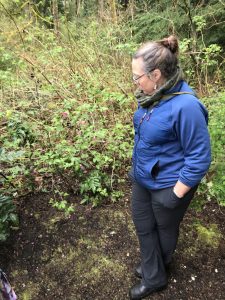 We left the classroom for a foraging walkabout on nearby Cougar Mountain. The day started cold, humid, damp the air swelling with moisture but not quite raining. We visited new and old friends along the way starting with salmonberry, Rubus spectabilis, the salmonberry, is one fo the earliest native plants to blossom in the Spring.
We left the classroom for a foraging walkabout on nearby Cougar Mountain. The day started cold, humid, damp the air swelling with moisture but not quite raining. We visited new and old friends along the way starting with salmonberry, Rubus spectabilis, the salmonberry, is one fo the earliest native plants to blossom in the Spring. 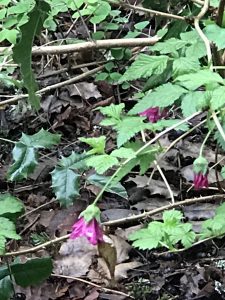 The plant has culinary, medicinal and utilitarian uses. It contains substantial amounts of Vitamins C and A and are a good source of calcium, potassium and iron. We gathered a few of the flower petals and tender new shoots for our salad.
The plant has culinary, medicinal and utilitarian uses. It contains substantial amounts of Vitamins C and A and are a good source of calcium, potassium and iron. We gathered a few of the flower petals and tender new shoots for our salad.
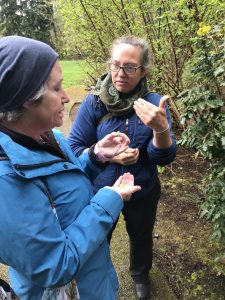 We met Oregon Grape, Mahonia Nervosa, which is known to regulate blood glucose levels, stop infections and modulate inflammation.. It contains berberine, a constituent that decreases bacterial resistance to antibiotics.
We met Oregon Grape, Mahonia Nervosa, which is known to regulate blood glucose levels, stop infections and modulate inflammation.. It contains berberine, a constituent that decreases bacterial resistance to antibiotics.  Studies are now using it to treat MRSA (Methicillin-resistant Staphylococcus aureus). We passed a creek bed lined with Skunk Cabbage, Lysichiton americanum, whose great leaves we used to wrap our fish while baking. Native people used the leaves to line their harvesting baskets and cover the contents. We harvested a few fiddleheads, the young, tender, tightly furled new growth shoots of the Lady fern, Athyrium fillip-femina. Karen planned to sauté them and incorporate them into our baked rice dish.
Studies are now using it to treat MRSA (Methicillin-resistant Staphylococcus aureus). We passed a creek bed lined with Skunk Cabbage, Lysichiton americanum, whose great leaves we used to wrap our fish while baking. Native people used the leaves to line their harvesting baskets and cover the contents. We harvested a few fiddleheads, the young, tender, tightly furled new growth shoots of the Lady fern, Athyrium fillip-femina. Karen planned to sauté them and incorporate them into our baked rice dish.  Fiddleheads are surprisingly nutritious with: antioxidants, vitamins (A, B & C), omega-3, omega-7 essential fatty acids and minerals (potassium, iron, manganese, and copper).
Fiddleheads are surprisingly nutritious with: antioxidants, vitamins (A, B & C), omega-3, omega-7 essential fatty acids and minerals (potassium, iron, manganese, and copper). 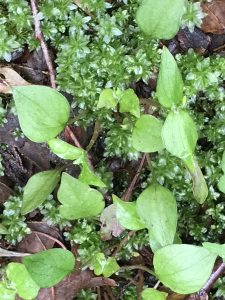 The trail was lined with Siberian miner’s lettuce , Claytonia sibirica, destined for our salad. This nutrient packed wild green superfood was once used by early gold prospectors to ward off scurvy.
The trail was lined with Siberian miner’s lettuce , Claytonia sibirica, destined for our salad. This nutrient packed wild green superfood was once used by early gold prospectors to ward off scurvy.
While visiting a stinging nettle, Urtica dioica, patch, Karen explained how to pick them with bare hands without getting stung. Nettles are covered with tiny hollow hairs, filled with irritating formic acid.
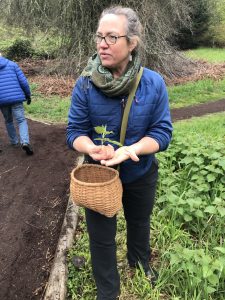 To harvest nettles with bare hands, you’ll need to learn to touch the plant without breaking the hairs. The key is that the hairs on the leaves all aim from the cleft or top of the leaf to the point or bottom of the leaf. If you run your finger from cleft to point, you will not get stung. Or so some say. Experience has taught me that I can “handle” these wonders with a minimal sting. But woe to me if I wash the dishes in hot water after touching nettles bare handed.
To harvest nettles with bare hands, you’ll need to learn to touch the plant without breaking the hairs. The key is that the hairs on the leaves all aim from the cleft or top of the leaf to the point or bottom of the leaf. If you run your finger from cleft to point, you will not get stung. Or so some say. Experience has taught me that I can “handle” these wonders with a minimal sting. But woe to me if I wash the dishes in hot water after touching nettles bare handed. 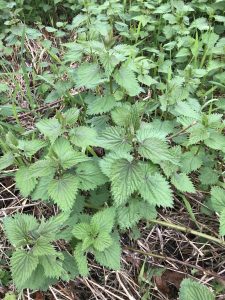 Why bother? Stinging nettle is high in iron and calcium, Vitamins A, B, C, D and K. It is delicious. You can use cooked nettles in place of spinach. Nettles invite you to use your culinary creativity as Karen did with her Crispy Marinated Nettle Chips!
Why bother? Stinging nettle is high in iron and calcium, Vitamins A, B, C, D and K. It is delicious. You can use cooked nettles in place of spinach. Nettles invite you to use your culinary creativity as Karen did with her Crispy Marinated Nettle Chips!
 Karen showed us the new buds on a Douglas Fir. Douglas fir offers anti-inflammatory, antiseptic, antimicrobial, expectorant, and sedative properties. Maybe this is why I crave walking in the woods!
Karen showed us the new buds on a Douglas Fir. Douglas fir offers anti-inflammatory, antiseptic, antimicrobial, expectorant, and sedative properties. Maybe this is why I crave walking in the woods! 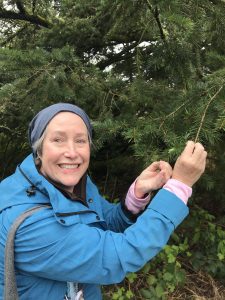 The needles are a great source of vitamin C, too. We’re using the bright green tender spring buds. You can also make a simple infusion/tea to enjoy the citrus-y flavor or add them to lemonade. I resist the urge to harvest too many – they are this beautiful tree’s new growth.
The needles are a great source of vitamin C, too. We’re using the bright green tender spring buds. You can also make a simple infusion/tea to enjoy the citrus-y flavor or add them to lemonade. I resist the urge to harvest too many – they are this beautiful tree’s new growth.
We gathered dandelion, Taraxacum official, leaves for the pesto topping on the beautiful poached Cabazon fish that Karen caught in Neah Bay waters. Our local dandelions are immigrants originating in Europe and Asia. People have been ingesting dandelion for both culinary and medicinal purposes for centuries. The greens provide 535 percent of the recommended daily value of Vitamin K, which helps strengthen bones and may also play a role in treating Alzheimer’s disease. They offer Vitamins A, B, C, thiamin, riboflavin, calcium, iron, potassium, magnesium and manganese among other minerals.
 We returned to Earthwalk’s cozy kitchen to assemble our feast. Karen had previously foraged beautiful wild oyster mushrooms for the coconut-curry soup that was simmering on the stove. Thanks to Karen and Janie, so many beautiful dishes were in various stages of completion.
We returned to Earthwalk’s cozy kitchen to assemble our feast. Karen had previously foraged beautiful wild oyster mushrooms for the coconut-curry soup that was simmering on the stove. Thanks to Karen and Janie, so many beautiful dishes were in various stages of completion.  It was fun to be cooking with foodie friends who aren’t afraid of getting their hands in the weeds.
It was fun to be cooking with foodie friends who aren’t afraid of getting their hands in the weeds.  Many hands went into making the dandelion wine we were about to enjoy. Aren’t many hands what make a meal a feast?
Many hands went into making the dandelion wine we were about to enjoy. Aren’t many hands what make a meal a feast?
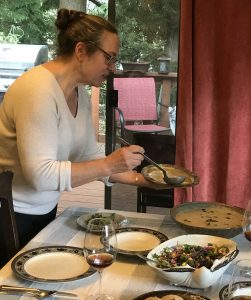 Whether it’s grown or caught, native people have worshipped foraged foods. Their relationship with the plants and animals they eat is one of kinship. Like all things in nature, food – living, wild food – is interconnected to our being. Karen held a gratitude ceremony to honor and share these life sustaining gifts. Each one of us placed a bit of our feast on a plate to give thanks and give back. I am so blessed and humbled to be in this good company.
Whether it’s grown or caught, native people have worshipped foraged foods. Their relationship with the plants and animals they eat is one of kinship. Like all things in nature, food – living, wild food – is interconnected to our being. Karen held a gratitude ceremony to honor and share these life sustaining gifts. Each one of us placed a bit of our feast on a plate to give thanks and give back. I am so blessed and humbled to be in this good company.
We gathered around the beautifully set table to celebrate and enjoy a wild menu:
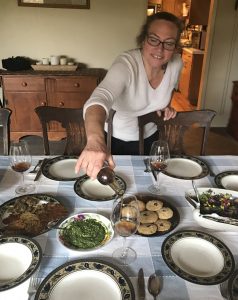 Seaweed Seasoned Cabazon poached in Skunk Cabbage Leaves
Seaweed Seasoned Cabazon poached in Skunk Cabbage Leaves
Dandelion Pesto
Crispy Marinated Nettle Chips
Wild Oyster Mushroom Coconut-Curry Soup
Savory Carrot Fennel Salad with Wood Sorrel, Salmonberry flowers & shoots, Miner’s lettuce, Chickweed and Dandelion
Baked Brown Rice & Quinoa with Stinging Nettle Garnished with sautéed
Lady fern Fiddleheads
Wild Spring Flower Shortbread Cookies
Dandelion Wine
If you want to learn more about foraging wild foods and traditional skills I encourage you to explore what Earthwalk Northwest has to offer. To listen to a heartfelt sharing of Karen’s devotion to bringing wild foods into our diet sustainably listen to this John Gallagher’s fascinating interview with Karen at HerbMentor Radio.
